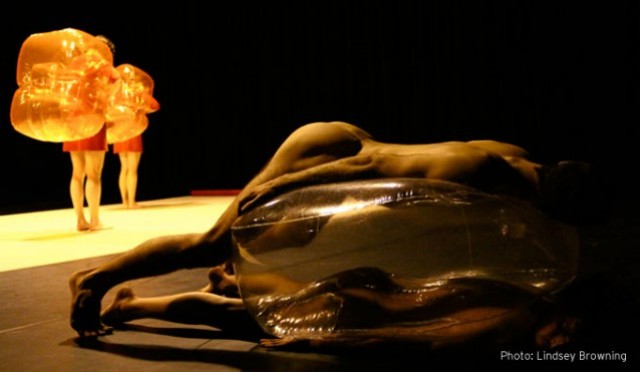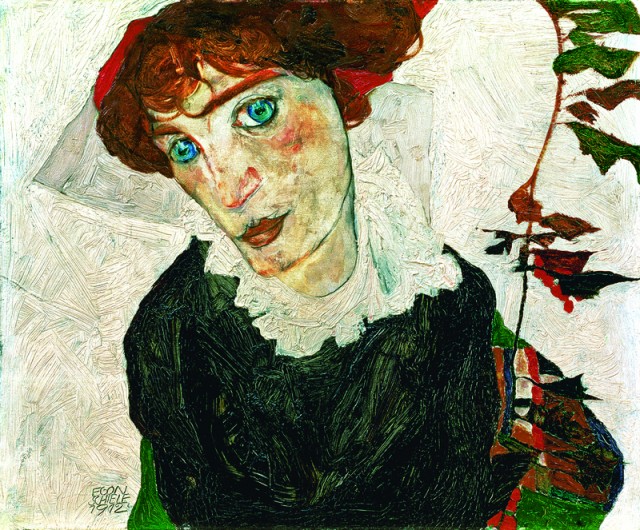Brooklyn-based experimental drummer and composer John Colpitts, also known as Kid Millions, has played percussion with such groups as Oneida and the Boredoms. Next week he is set to release his second album as Man Forever, Pansophical Cataract (Thrill Jockey, May 15, 2012). Inspired by Lou Reed’s Metal Machine Music, the album consists of two long tracks built around propulsive drum rolls that sound as if they are about to introduce something that never quite arrives. But both the thirty-minute “Surface Patterns” and the forty-minute “UR Eternity” are filled with little surprises as they unfold, electric instruments or bass adding bits of drone, mystery, and nuance here and there. It’s like an audio version of Michael Snow’s avant-garde classic Wavelength, in which a camera makes its way slowly across an apartment, oblivious to anything that happens in the room as it approaches the wall ― and then beyond. For the “Surface Patterns” video, Colpitts recruited a group of musicians who have played with Man Forever, including Sarah Richardson, Richard Hoffman, Brad Truax, Shahin Motia, Leah McManigle, and Brian Chase; on May 15, Richardson, Hoffman, Motia, and Chase, along with James McNew, Bryan Devendorf, Ryan Sawyer, Greg Fox, and Oran Canfield, will join Kid Millions for an album release party at (le) poisson rouge, with the Colin Langenus Orchestra and Nymph opening the show. Man Forever then heads out across the country before returning for performances June 29 at Issue Project Room and July 11 at the Stone.
Yearly Archives: 2012
SUNDAY SESSIONS: TARYN SIMON
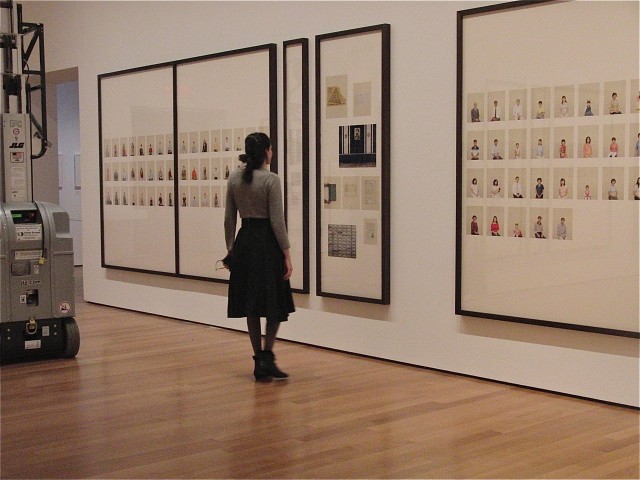
Taryn Simon examines her new photography installation at MoMA and will discuss it on May 13 at MoMA PS1 (photo by twi-ny/mdr)
A LIVING MAN DEAD AND OTHER CHAPTERS I-XVIII
MoMA PS1
22-25 Jackson Ave. at 46th Ave.
Sunday, May 14, $10, 12 noon – 6:00
718-784-2084
www.ps1.org
As it prepares for its summer Warm Up series, MoMA PS1’s final Sunday Sessions program will be held on May 13. In addition to your last chance to see the exhibitions “Darren Bader: Images” and “Kraftwerk ― Retrospective 1 2 3 4 5 6 7 8,” both of which close on Monday, legendary DJ Afrika Bambaataa will pay tribute to the German electronic music pioneers from 3:00 to 6:00 in the Performance Dome. Also at 3:00, artbook @ moma ps1 will host the book discussion group “A Short Course on Resistance.” Food will be available from Long Island City favorites M. Wells, and the exhibitions “Lara Favaretto: Just Knocked Out,” “Max Brand: no solid footing ― (trained) duck fighting a crow,” “Rania Stephan,” and “Frances Stark: My Best Thing” will also be open. We’re most looking forward to the 2:00 conversation between native New York artist Taryn Simon and MoMA PS1 associate curator Jenny Schlenzka on the occasion of the publication of Simon’s A Living Man Declared Dead and Other Chapters, I-XVIII, the catalog to the exhibition currently on view in MoMA’s photography wing. Native New Yorker Simon, whose “Contraband” filled the Lever House lobby in late 2010 with thousands of photos of items that were confiscated at JFK International Airport, has now turned her attention on bloodlines, cataloging families from around the world, organizing them in very specific order, accompanied by photos of documents and other paraphernalia relating to their story. Nine of the chapters can be seen at MoMA, including the Indian Yadav clan, which is fighting to regain land they lost when Shivdutt Yadav was wrongly listed as being deceased; the Ondijos of Kenya, where HIV/AIDS doctor Joseph Nyamwanda Jura Ondijo has nine wives, thirty-two children, and sixty-three grandchildren; the sadly small Mehićs and Nukićs of Bosnia and Herzegovina, victims of genocide; the Chinese family of Su Qijian, declared by China’s State Council Information Office as the best representative of multigenerational Chinese bloodlines; and a large group of children living in a Ukrainian orphanage. Simon also spends one chapter depicting dozens of Australian rabbits used for experimentation that ultimately died during the tests or were later euthanized. A Living Man Declared Dead and Other Chapters, which continues at MoMA through September 3, is a fascinating, involving collection of photographs of life and death, of science and politics, of the known and the unknown, intricately organized and arranged to create a complex, compelling visual narrative.
FORT BLOSSOM REVISITED (2000/2012)
FORT BLOSSOM REVISITED (2000/2012)
New York Live Arts
219 West 19th St. between Seventh & Eighth Aves.
May 9-12, $15-$30, 7:30
May 11, 10:00 pm show added by popular demand
212-691-6500
www.newyorklivearts.org
www.johnjasperse.org
John Jasperse once again turns expectations inside out and upside down with Fort Blossom revisited. An updated, expanded version of a 2000 work he appeared in, the piece features two clothed women, Lindsay Clark and Erika Hand, and two nude men, Ben Asriel and Burr Johnson. (The 2000 piece was performed by Jasperse, Miguel Gutierrez, Parker Lutz, and Juliette Mapp.) The quartet interacts with one another and a group of plastic inflatables, using them as furniture, toys, costumes, and sexual barriers. Moving on and off a rolled vertical canvas while experimental noise by Ryoji Ikeda rumbles in the background or goes silent for extended moments, the dancers, paired off by gender for most of the show, bring their bodies together in mesmerizing, breathtaking, awe-inspiring, and taboo-busting ways, particularly Asriel and Johnson, who examine every nook and cranny of their bodies, every crevice, rubbing, pumping, and melding into architectural and sculptural forms rarely seen onstage in such bare glory. Fort Blossom revisited is a spectacular achievement, a brutally honest and challenging work from one of the dance world’s most innovative choreographers. (For more on Jasperse and Fort Blossom revisited, read our twi-ny talk with him here.)
AN EARLY HISTORY OF FIRE
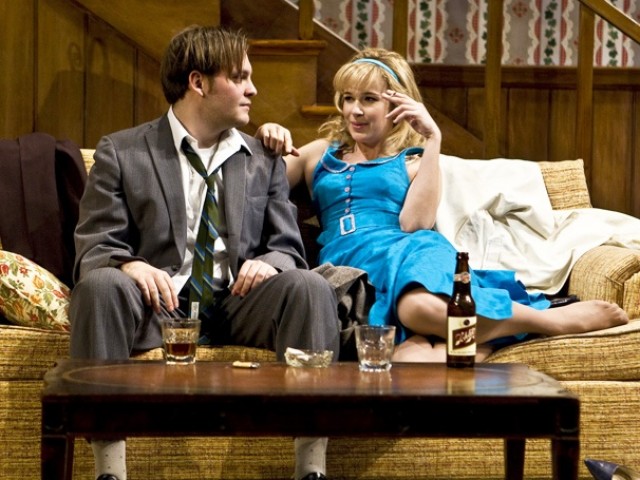
Danny (Theo Stockman) and Karen (Claire van der Boom) are in for a long night in David Rabe’s AN EARLY HISTORY OF FIRE (photo by Monique Carboni)
The Acorn Theatre at Theatre Row
410 West 42nd St. between Ninth & Tenth Aves.
Monday – Saturday through May 26, $61.25
212-560-2183
www.thenewgroup.org
www.theatrerow.org
Despite all the talk of burning hilltops and yearning young passion, award-winning playwright David Rabe’s An Early History of Fire never quite ignites at the Acorn Theatre at Theatre Row. Lightning doesn’t strike twice for the New Group, which staged a popular revival of Rabe’s Tony-nominated Hurlyburly in 2005, featuring the all-star cast of Bobby Cannavale, Josh Hamilton, Ethan Hawke, Parker Posey, and Wallace Shawn. Rabe, who has penned such other works as Sticks and Bones, The Basic Training of Pavlo Hummel, and In the Boom Boom Room, goes back to 1962 in his first new play since 2001’s The Dog Problem, but it turns out to be a rather mundane time-capsule drama. Theo Stockman stars as Danny, a serious young man living with his immigrant father, Emil (Gordon Clapp), in a working-class town in Middle America. When Danny begins dating Karen (Claire van der Boom), the daughter of a wealthy family in a nearby ritzy neighborhood, his best friend, Terry (Jonny Orsini), is insulted, claiming that Danny is turning his back on his roots. But Danny is enlightened by Karen’s discussions of literature and politics, although he starts finding out a lot more about her on one very long night. An Early History of Fire is a coming-of-age drama that never comes of age itself, instead emerging flat and old-fashioned. When Karen waxes poetic about Salinger and Kerouac, or when the play comes to an uncomfortable stop as everyone pauses to listen to an Elvis Presley song on the hi-fi, it feels like Rabe is forcing his own personal heroes into the story, resulting in moments that are unnatural and inorganic. An Early History of Fire does have the air of autobiography about it ― Rabe was born and raised in Dubuque, Iowa, in a working-class family, and he would have been twenty-two in 1962 ― but it has trouble escaping its own insecurities, much as Danny has trouble escaping his.
I WISH (KISEKI)
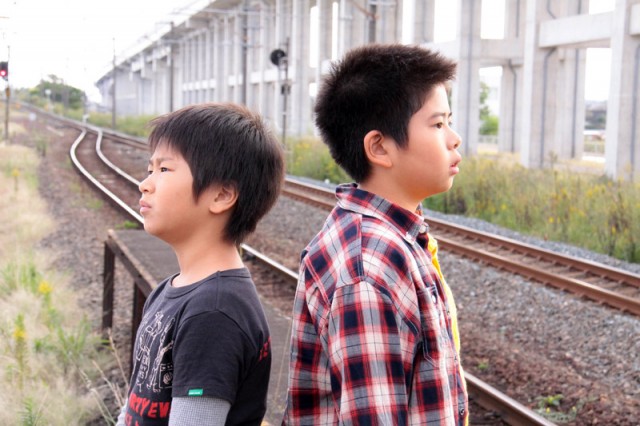
Real-life brothers Ohshirô Maeda and Koki Maeda star as close siblings in Hirokazu Kore-eda’s masterful I WISH
I WISH (KISEKI) (Hirokazu Kore-eda, 2011)
Lincoln Plaza Cinema, 1886 Broadway at 63rd St., 212-757-2280
Angelika Film Center, 18 West Houston St. at Mercer St., 212-995-2570
Opens Friday, May 11
www.magpictures.com/iwish
 Japanese auteur Hirokazu Kore-eda’s I Wish is an utterly delightful, absolutely charming tale of family and all of the hopes and dreams associated with it. Real-life brothers Koki Maeda and Ohshirô Maeda of the popular MaedaMaeda comedy duo star as siblings Koichi and Ryu, who have been separated as a result of their parents’ divorce. Twelve-year-old Koichi (Koki) lives with his mother (Nene Ohtsuka) and maternal grandparents (Kirin Kiki and Isao Hashizume) in Kagoshima in the shadow of an active volcano that continues to spit ash out all over the town, while the younger Ryu lives with his father (Joe Odagiri), a wannabe rock star, in Fukuoka. When Koichi hears that if a person makes a wish just as the two new high-speed bullet trains pass by each other for the first time the wish will come true, he decides he must do everything in his power to be there, along with Ryu, so they can wish for their family to get back together. Kore-eda, who has previously explored the nature of family in such powerful films as Maborosi, Nobody Knows, and Still Walking, once again displays his deft touch at handling complex relationships in I Wish, the Japanese title of which is Kiseki, or Miracle. Originally intended to be a film about the new Kyushu Shinkansen bullet train, the narrative shifted once Kore-eda auditioned the Maeda brothers, deciding to make them the center of the story, and they shine as two very different siblings, one young and impulsive, the other older and far more serious. Everyone in the film, child and adult, wishes for something more out of life, whether realistic or not. Ryu’s friend Megumi (Kyara Uchida) wants to be an actress; Koichi’s friend Makoto (Seinosuke Nagayoshi) wants to be just like his hero, baseball star Ichiro Suzuki; and the brothers’ grandfather wants to make a subtly sweet, old-fashioned karukan cake that people will appreciate. Much of the dialogue is improvised, including by the children, lending a more realistic feel to the film, although it does get a bit too goofy in some of its later scenes. Written, directed, and edited by Kore-eda, I Wish is a loving, bittersweet celebration of the child in us all.
Japanese auteur Hirokazu Kore-eda’s I Wish is an utterly delightful, absolutely charming tale of family and all of the hopes and dreams associated with it. Real-life brothers Koki Maeda and Ohshirô Maeda of the popular MaedaMaeda comedy duo star as siblings Koichi and Ryu, who have been separated as a result of their parents’ divorce. Twelve-year-old Koichi (Koki) lives with his mother (Nene Ohtsuka) and maternal grandparents (Kirin Kiki and Isao Hashizume) in Kagoshima in the shadow of an active volcano that continues to spit ash out all over the town, while the younger Ryu lives with his father (Joe Odagiri), a wannabe rock star, in Fukuoka. When Koichi hears that if a person makes a wish just as the two new high-speed bullet trains pass by each other for the first time the wish will come true, he decides he must do everything in his power to be there, along with Ryu, so they can wish for their family to get back together. Kore-eda, who has previously explored the nature of family in such powerful films as Maborosi, Nobody Knows, and Still Walking, once again displays his deft touch at handling complex relationships in I Wish, the Japanese title of which is Kiseki, or Miracle. Originally intended to be a film about the new Kyushu Shinkansen bullet train, the narrative shifted once Kore-eda auditioned the Maeda brothers, deciding to make them the center of the story, and they shine as two very different siblings, one young and impulsive, the other older and far more serious. Everyone in the film, child and adult, wishes for something more out of life, whether realistic or not. Ryu’s friend Megumi (Kyara Uchida) wants to be an actress; Koichi’s friend Makoto (Seinosuke Nagayoshi) wants to be just like his hero, baseball star Ichiro Suzuki; and the brothers’ grandfather wants to make a subtly sweet, old-fashioned karukan cake that people will appreciate. Much of the dialogue is improvised, including by the children, lending a more realistic feel to the film, although it does get a bit too goofy in some of its later scenes. Written, directed, and edited by Kore-eda, I Wish is a loving, bittersweet celebration of the child in us all.
PORTRAIT OF WALLY
PORTRAIT OF WALLY (Andrew Shea, 2012)
Quad Cinema
34 West 13th St.
Opens Friday, May 11
212-255-2243
www.quadcinema.com
portraitofwally.com
 An exciting, fast-paced documentary set in the high-stakes art world, Andrew Shea’s Portrait of Wally is a gripping real-life legal thriller, complete with international intrigue, love and death, class warfare, lies and deception, and Nazis. In 1912, Austrian artist Egon Schiele painted a small portrait of his mistress, Walburga (“Wally”) Neuzil, in addition to a companion self-portrait. In 1939, the painting of Wally was stolen from art dealer Lea Bondi’s personal collection by Friedrich Welz, a Nazi who had also taken over Bondi’s gallery because she was Jewish. When the painting suddenly showed up in New York City in 1997 as part of the Museum of Modern Art’s “Egon Schiele: The Leopold Collection” exhibition, a furious, angry thirteen-year battle ensued over ownership of the work, involving Manhattan district attorney Robert Morgenthau; MoMA director Glenn D. Lowry; Sharon Cohen Levin, chief of the Asset Forfeiture Unit of the U.S. Attorney’s Office; investigator Willi Korte of the Holocaust Art Restitution Project; Schiele-obsessed art collector Rudolf Leopold; and the Bondi family. Other major museums sided with MoMA in a concerted effort to prevent the government from returning the painting to the Bondis, claiming that it would seriously damage the ability of art institutions to bring works on loan for exhibition in the United States; interestingly, Lowry and MoMA chairman Ronald S. Lauder, who is also the head of the Commission for Art Recovery and displays many of Schiele’s paintings and drawings at his Neue Galerie in New York City, opted not to speak with Shea, but the filmmaker did meet with Morgenthau, Levin, André Bondi, New York Times reporter Judith Dobrzynski, 60 Minutes journalist Morley Safer, Galerie St. Etienne owner and Schiele expert Jane Kallir, and others who share fascinating details about the personal and professional history of Schiele and the painting as well as the inner workings of the art world. Mixing archival footage with new interviews, Shea and his wife, editor Melissa Shea, tell a compelling tale of global importance filled with powerful emotion that, in many ways, evokes the feeling one gets when looking closely at a master work of art. But Portrait of Wally is about a lot more than just art; it is also about memory, about family, about responsibility, and about justice.
An exciting, fast-paced documentary set in the high-stakes art world, Andrew Shea’s Portrait of Wally is a gripping real-life legal thriller, complete with international intrigue, love and death, class warfare, lies and deception, and Nazis. In 1912, Austrian artist Egon Schiele painted a small portrait of his mistress, Walburga (“Wally”) Neuzil, in addition to a companion self-portrait. In 1939, the painting of Wally was stolen from art dealer Lea Bondi’s personal collection by Friedrich Welz, a Nazi who had also taken over Bondi’s gallery because she was Jewish. When the painting suddenly showed up in New York City in 1997 as part of the Museum of Modern Art’s “Egon Schiele: The Leopold Collection” exhibition, a furious, angry thirteen-year battle ensued over ownership of the work, involving Manhattan district attorney Robert Morgenthau; MoMA director Glenn D. Lowry; Sharon Cohen Levin, chief of the Asset Forfeiture Unit of the U.S. Attorney’s Office; investigator Willi Korte of the Holocaust Art Restitution Project; Schiele-obsessed art collector Rudolf Leopold; and the Bondi family. Other major museums sided with MoMA in a concerted effort to prevent the government from returning the painting to the Bondis, claiming that it would seriously damage the ability of art institutions to bring works on loan for exhibition in the United States; interestingly, Lowry and MoMA chairman Ronald S. Lauder, who is also the head of the Commission for Art Recovery and displays many of Schiele’s paintings and drawings at his Neue Galerie in New York City, opted not to speak with Shea, but the filmmaker did meet with Morgenthau, Levin, André Bondi, New York Times reporter Judith Dobrzynski, 60 Minutes journalist Morley Safer, Galerie St. Etienne owner and Schiele expert Jane Kallir, and others who share fascinating details about the personal and professional history of Schiele and the painting as well as the inner workings of the art world. Mixing archival footage with new interviews, Shea and his wife, editor Melissa Shea, tell a compelling tale of global importance filled with powerful emotion that, in many ways, evokes the feeling one gets when looking closely at a master work of art. But Portrait of Wally is about a lot more than just art; it is also about memory, about family, about responsibility, and about justice.
NOBODY ELSE BUT YOU (POUPOUPIDOU)
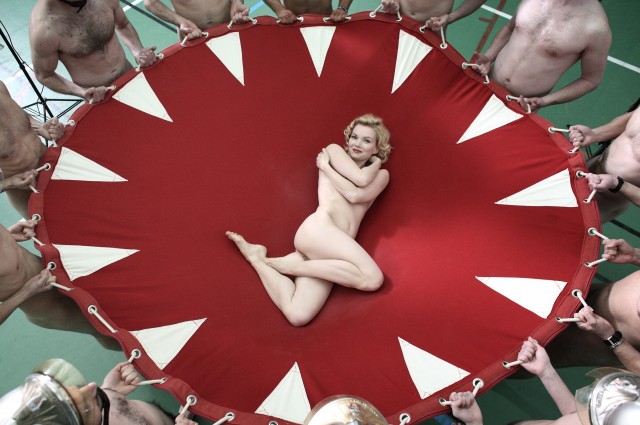
Sophie Quinton channels the body and spirit of Marilyn Monroe in NOBODY ELSE BUT YOU (photo by Jean-Claude Lother)
NOBODY ELSE BUT YOU (POUPOUPIDOU) (Gérald Hustache-Mathieu, 2011)
Cinema Village
22 East 12th St. between University Pl. & Fifth Ave.
Opens Friday, May 11
212-924-3363
firstrunfeatures.com
www.cinemavillage.com
 After returning to his childhood vacation town of Mouthe, the coldest village in France, only to be told that his recently deceased uncle left him a stuffed dog instead of his eight-hectare vineyard, crime novelist David Rousseau (Jean-Paul Rouve), who is suffering from writer’s block, suddenly comes upon an idea for his next book. He decides to investigate the surprise suicide of Mouthe’s beloved favorite daughter, Candice Lecouer (Sophie Quinton), a beautiful young blonde who was the face of the town’s leading export, Belle de Jura cheese. Against the firm advice of Brigadier Bruno Leloup (Guillaume Gouix) and Commandant Colbert (Olivier Rabourdin) of the local police, Rousseau snoops into Candice’s past, which he quickly discovers is eerily reminiscent of the life and death of her hero, Norma Jean Baker / Marilyn Monroe. As he gets closer to the truth, however, he finds that playing detective is a lot more dangerous than he imagined. Writer-director Gérald Hustache-Mathieu (April in Love) has fashioned a thrilling modern noir with Nobody Else But You, a gorgeously shot tale of lust, pride, ambition, self-doubt, and obsession, with more than a hint of the surreal and liberal splashes of wry humor. Hustache-Mathieu brings the dead Candice back to life through flashbacks as well as voice-overs not only of her reading from her diaries but narrating from beyond the grave. The film sparkles whenever Quinton is onscreen, the actress casting an enchanting glow that rivals the almost blindingly white snowy landscapes of Mouthe, with expert cinematography courtesy of Pierre Cottereau that evokes the Coen brothers’ Fargo. The fourth collaboration between the radiant Quinton and Hustache-Mathieu, Nobody Else But You, which also boasts an eclectic soundtrack and compelling original score by Stéphane Lopez — and whose English and French (Poupoupidou) titles are both taken from the lyrics of Monroe’s famous song “I Wanna Be Loved by You” — is a rousing good mystery with an engaging balance of the lurid and the erotic.
After returning to his childhood vacation town of Mouthe, the coldest village in France, only to be told that his recently deceased uncle left him a stuffed dog instead of his eight-hectare vineyard, crime novelist David Rousseau (Jean-Paul Rouve), who is suffering from writer’s block, suddenly comes upon an idea for his next book. He decides to investigate the surprise suicide of Mouthe’s beloved favorite daughter, Candice Lecouer (Sophie Quinton), a beautiful young blonde who was the face of the town’s leading export, Belle de Jura cheese. Against the firm advice of Brigadier Bruno Leloup (Guillaume Gouix) and Commandant Colbert (Olivier Rabourdin) of the local police, Rousseau snoops into Candice’s past, which he quickly discovers is eerily reminiscent of the life and death of her hero, Norma Jean Baker / Marilyn Monroe. As he gets closer to the truth, however, he finds that playing detective is a lot more dangerous than he imagined. Writer-director Gérald Hustache-Mathieu (April in Love) has fashioned a thrilling modern noir with Nobody Else But You, a gorgeously shot tale of lust, pride, ambition, self-doubt, and obsession, with more than a hint of the surreal and liberal splashes of wry humor. Hustache-Mathieu brings the dead Candice back to life through flashbacks as well as voice-overs not only of her reading from her diaries but narrating from beyond the grave. The film sparkles whenever Quinton is onscreen, the actress casting an enchanting glow that rivals the almost blindingly white snowy landscapes of Mouthe, with expert cinematography courtesy of Pierre Cottereau that evokes the Coen brothers’ Fargo. The fourth collaboration between the radiant Quinton and Hustache-Mathieu, Nobody Else But You, which also boasts an eclectic soundtrack and compelling original score by Stéphane Lopez — and whose English and French (Poupoupidou) titles are both taken from the lyrics of Monroe’s famous song “I Wanna Be Loved by You” — is a rousing good mystery with an engaging balance of the lurid and the erotic.
